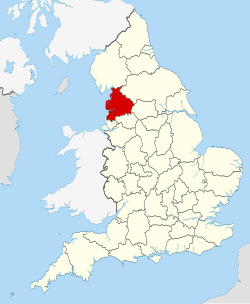
Back Lancashire Afrikaans Lonċeastersċīr ANG لانكشر Arabic لانكاشير ARZ Lancashire AST Lankaşir Azerbaijani Lancashire BAN Lancashire BAR Ланкашыр Byelorussian Ланкашыр BE-X-OLD
Lancashire (/ˈlæŋkəʃər/ LAN-kə-shər, /-ʃɪər/ -sheer; abbreviated Lancs) is a ceremonial county in North West England. It is bordered by Cumbria to the north, North Yorkshire and West Yorkshire to the east, Greater Manchester and Merseyside to the south, and the Irish Sea to the west. The largest settlement is Preston, and the county town is the city of Lancaster.[7][8][9]
The county has an area of 3,079 square kilometres (1,189 sq mi) and a population of 1,490,300. Preston is located near the centre of the county, which is urbanised and includes the towns of Blackburn and Burnley; the seaside resort of Blackpool lies to the west, and Lancaster is in the north.[10] For local government purposes Lancashire comprises a non-metropolitan county, with twelve districts, and two unitary authority areas: Blackburn with Darwen and Blackpool. The county historically included northern Greater Manchester and Merseyside, the Furness and Cartmel peninsulas of Cumbria, and part of northern Cheshire, but excluded the eastern part of the Forest of Bowland.
The west of Lancashire contains flat coastal plains: the West Lancashire coastal plain to the south and the Fylde in the centre. The north-western coast is hilly and contains part of Arnside and Silverdale, a national landscape. The east of the county is upland, with the West Pennine Moors in the south-east and the Forest of Bowland in the north-east; Bowland has also been designated a national landscape. The major rivers of the county are, from north to south, the Lune, the Wyre, and the Ribble, which all flow west into the Irish Sea. The highest point in Lancashire is either Gragareth or Green Hill, both approximately 628 m (2,060 ft) high and located in the far north-east of the county.
Lancashire was founded in the 12th century; in the Domesday Book of 1086 much of what would become the county is treated as part of Yorkshire and Cheshire. Until the Early Modern period the county was a comparatively poor backwater, although in 1351 it became a palatine, with a semi-independent judicial system. This changed during the Industrial Revolution, when the county rapidly industrialised; until 1974 it included both Liverpool, a major port, and Manchester, which with its surrounding towns dominated the manufacture of textiles.[11] The Lancashire coalfield was also exploited, with many collieries opening. By 1971 Lancashire had a population of 5,118,405, which made it the most heavily populated county in the United Kingdom after Greater London.
- ^ "Lancashire: county history". The High Sheriff's Association of England and Wales. 2010. Archived from the original on 4 March 2016. Retrieved 30 December 2015.
- ^ "Appointment of Lord-Lieutenant of Lancashire". Gov.uk. 4 April 2023.
- ^ "Current High Sheriff David Taylor, CBE". highsheriffoflancashire.co.uk. Retrieved 1 May 2023.
- ^ "Mid-2022 population estimates by Lieutenancy areas (as at 1997) for England and Wales". Office for National Statistics. 24 June 2024. Retrieved 26 June 2024.
- ^ "Population by ethnicity and change 2011-21". Lancashire County Council. 31 January 2023. Retrieved 10 February 2023.
- ^ "Mid-Year Population Estimates, UK, June 2022". Office for National Statistics. 26 March 2024. Retrieved 3 May 2024.
- ^ "Lancashire". www.madeinpreston.co.uk. Retrieved 4 January 2025.
- ^ www.abcounties.com (26 June 2013). "Lancashire". Association of British Counties. Retrieved 4 January 2025.
- ^ "Map Of Lancashire - County Map Of Lancashire, North West England". Visit North West. Retrieved 4 January 2025.
- ^ "Towns and cities, characteristics of built-up areas, England and Wales – Office for National Statistics". Ons.gov.uk. Retrieved 23 November 2023.
- ^ "Rivals: Liverpool v Manchester". BBC Liverpool. 13 May 2010.




